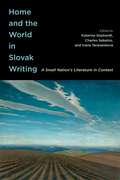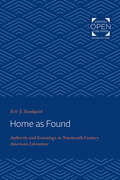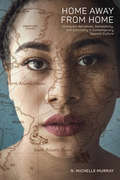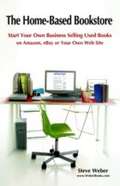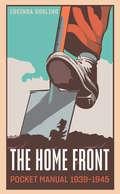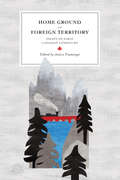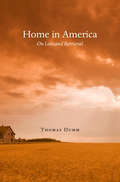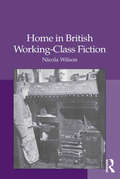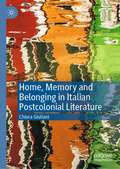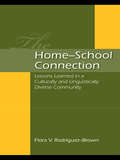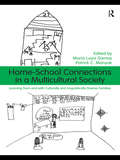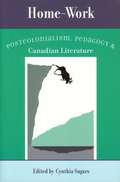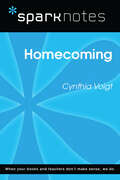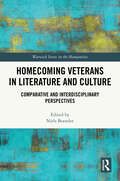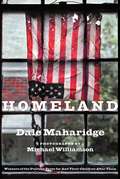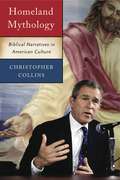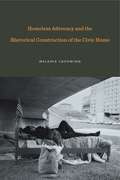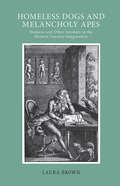- Table View
- List View
Home and Nation in Anglophone Autobiographies of Africa (African Histories and Modernities)
by Lena EnglundThis book looks at contemporary autobiographical works by writers with African backgrounds in relation to the idea of ‘place’. It examines eight authors’ works – Helen Cooper’s The House at Sugar Beach, Sisonke Msimang’s Always Another Country, Leila Ahmed’s A Border Passage, Noo Saro-Wiwa’s Looking for Transwonderland, Douglas Rogers’s The Last Resort, Elamin Abdelmahmoud’s Son of Elsewhere, Clemantine Wamariya and Elizabeth Weil’s The Girl Who Smiled Beads and Aminatta Forna’s autobiographical writing – to argue that place is particularly central to personal narrative in texts whose authors have migrated multiple times. Spanning Liberia, Nigeria, Sierra Leone, Egypt, Rwanda, Zambia, and Zimbabwe, this book interrogates the label ‘African’ writing which has been criticized for ignoring local contexts. It demonstrates how in their works these writers seek to reconnect with a bygone ‘Africa’, often after complex experiences of political upheavals and personal loss. The chapters also provide in-depth analyses of key concepts related to place and autobiography: place and privilege, place and trauma, and the relationship between place and nation.
Home and Nation in British Literature from the English to the French Revolutions
by Cousins, A. D. and Payne, Geoffrey A. d. Cousins Geoffrey PayneIn a world of conflicting nationalist claims, mass displacements and asylum-seeking, a great many people are looking for 'home' or struggling to establish the 'nation'. These were also important preoccupations between the English and the French revolutions: a period when Britain was first at war within itself, then achieved a confident if precarious equilibrium, and finally seemed to have come once more to the edge of overthrow. In the century and a half between revolution experienced and revolution observed, the impulse to identify or implicitly appropriate home and nation was elemental to British literature. This wide-ranging study by international scholars provides an innovative and thorough account of writings that vigorously contested notions and images of the nation and of private domestic space within it, tracing the larger patterns of debate, while at the same time exploring how particular writers situated themselves within it and gave it shape.
Home and the World in Slovak Writing: A Small Nation’s Literature in Context
by Katarina Gephardt, Charles Sabatos, and Ivana TaranenkováLiteratures of small nations represent a minuscule portion of the global literary marketplace, where books written in English outnumber translated works. The struggle for visibility in relation to dominant languages and cultures is not new in Slovakia, a nation of five million whose literary history has been shaped by the influence of more widely spoken languages including Hungarian, Czech, and Russian.Home and the World in Slovak Writing brings Slovak literature out of this isolation to tell the story of how a nation’s literature can survive and thrive despite a small domestic audience and relatively limited circulation in English translation. The book demonstrates how historic events such as the post-Stalin Thaw, the Prague Spring, and the Velvet Revolution moulded the Slovak canon and situates contemporary Slovak literature in broader regional and global contexts. Through case studies of the transformations and adaptations of Slovak literature, contributors examine the changing social roles of writers, the tensions between tradition and innovation, and the dynamic interactions between influences from the outside world and domestic sources of inspiration.Home and the World in Slovak Writing maps the relationship between geopolitical destiny and literary production at a critical moment. As relations between the East and the West are destabilized by war, the question of cultural identity has again become a matter of national survival in Central Europe.
Home as Found: Authority and Genealogy in Nineteenth-Century American Literature
by Eric J. SundquistOriginally published in 1979. Eric Sundquist takes four representative writers—James Fenimore Cooper, Henry David Thoreau, Nathaniel Hawthorne, and Herman Melville—and considers the way in which each grapples with the crucial issues of genealogy and authority in his works. From all four a common pattern emerges: the desire to revolt against the past is countered by the need to invoke or even repeat it. Sundquist's approach to the texts is psychoanalytic, but he does not attempt a clinical dissection of each writer; rather, he determines how personal crisis became material for engaging with larger questions of social and literary crisis.
Home Away from Home: Immigrant Narratives, Domesticity, and Coloniality in Contemporary Spanish Culture (North Carolina Studies in the Romance Languages and Literatures #315)
by N. Michelle MurrayHome Away from Home: Immigrant Narratives, Domesticity, and Coloniality in Contemporary Spanish Culture examines ideological, emotional, economic, and cultural phenomena brought about by migration through readings of works of literature and film featuring domestic workers. In the past thirty years, Spain has experienced a massive increase in immigration. Since the 1990s, immigrants have been increasingly female, as bilateral trade agreements, migration quotas, and immigration policies between Spain and its former colonies (including the Dominican Republic, Ecuador, Equatorial Guinea, and the Philippines) have created jobs for foreign women in the domestic service sector. These migrations reveal that colonial histories continue to be structuring elements of Spanish national culture, even in a democratic era in which its former colonies are now independent. Migration has also transformed the demographic composition of Spain and has created complex new social relations around the axes of gender, race, and nationality. Representations of migrant domestic workers provide critical responses to immigration and its feminization, alongside profound engagements with how the Spanish nation has changed since the end of the Franco era in 1975. Throughout Home Away from Home, readings of works of literature and film show that texts concerning the transnational nature of domestic work uniquely provide a nuanced account of the cultural shifts occurring in late twentieth- through twenty-first-century Spain.
The Home-based Bookstore: Start Your Own Business Selling Used Books on Amazon, Ebay or Your Own Web Site
by Steve WeberShows you how to open a used bookstore and sell on amazon.com, ebay.com, or other sites, with a concentration on amazon.com. Discusses where to find books, good business practices, and tools that can help you with your book business.
A Home for Moles
by Lei Ling Cindy Peattie Joan CzernichowskaTitle contained within StartUp Phonic Core Program. Not Sold Separately
The Home Front Pocket Manual, 1939–1945 (The\pocket Manual Ser.)
by Lucinda GoslingThis compilation of WWII-era magazine articles is &“a really useful reference guide covering aspects of life in the 1940s . . . packed with information&” (Home Front History). This manual brings together articles from stylish contemporary magazines of Britain during the World War II era, including Britannia & Eve, the Illustrated Sporting and Dramatic News, and Tatler, on all aspects of life on the home front. These fascinating articles cover complying with black-out regulations; what to do with the family car; augmenting rationed foods and turning them into tasty meals; contributing to the war effort by keeping livestock, salvaging valuable materials, and growing food—all, of course, while remaining fashionable and keeping up appearances.
Home Ground
by Debra Gwartney Barry LopezPublished to great acclaim in 2006, the hardcover edition of Home Ground: Language for an American Landscape met with outstanding reviews and strong sales, going into three printings. A language-lover's dream, Home Ground revitalized a descriptive language for the American landscape by combining geography, literature, and folklore in one volume. Now in paperback, this visionary reference is available to an entire new segment of readers. Home Ground brings together 45 poets and writers to create more than 850 original definitions for words that describe our lands and waters. The writers draw from careful research and their own distinctive stylistic, personal, and regional diversity to portray in bright, precise prose the striking complexity of the landscapes we inhabit. Home Ground includes 100 black-and-white line drawings by Molly O'Halloran and an introductory essay by Barry Lopez.
Home Ground
by Barry Lopez Debra GwartneyPublished to great acclaim in 2006, the hardcover edition of Home Ground: Language for an American Landscape met with outstanding reviews and strong sales, going into three printings. A language-lover's dream, Home Ground revitalized a descriptive language for the American landscape by combining geography, literature, and folklore in one volume. Now in paperback, this visionary reference is available to an entire new segment of readers. Home Ground brings together 45 poets and writers to create more than 850 original definitions for words that describe our lands and waters. The writers draw from careful research and their own distinctive stylistic, personal, and regional diversity to portray in bright, precise prose the striking complexity of the landscapes we inhabit. Home Ground includes 100 black-and-white line drawings by Molly O'Halloran and an introductory essay by Barry Lopez.
Home Ground and Foreign Territory: Essays on Early Canadian Literature (Reappraisals: Canadian Writers)
by Janice FiamengoHome Ground and Foreign Territory is an original collection of essays on early Canadian literature in English. Aiming to be both provocative and scholarly, it encompasses a variety of (sometimes opposing) perspectives, subjects, and methods, with the aim of reassessing the field, unearthing neglected texts, and proposing new approaches to canonical authors. Renowned experts in early Canadian literary studies, including D.M.R. Bentley, Mary Jane Edwards, and Carole Gerson, join emerging scholars in a collection distinguished by its clarity of argument and breadth of reference. Together, the essays offer bold and informative contributions to the study of this dynamic literature. Home Ground and Foreign Territory reaches out far beyond the scope of early Canadian literature. Its multi-disciplinary approach innovates literal studies and appeals to literature specialists and general readership alike.
Home in America: On Loss and Retrieval
by Thomas DummAmericans encounter their homes in ways comforting and haunting: as an imagined refuge or a place of mastery and domination, a destination or a place to escape. Drawing on literature, personal experience, and the histories of slavery, incarceration, and homesteading, Thomas Dumm offers a meditation on the richness and poverty of the idea of home.
Home in British Working-Class Fiction
by Nicola WilsonHome in British Working-Class Fiction offers a fresh take on British working-class writing that turns away from a masculinist, work-based understanding of class in favour of home, gender, domestic labour and the family kitchen. As Nicola Wilson shows, the history of the British working classes has often been written from the outside, with observers looking into the world of the inhabitants. Here Wilson engages with the long cultural history of this gaze and asks how ’home’ is represented in the writing of authors who come from a working-class background. Her book explores the depiction of home as a key emotional and material site in working-class writing from the Edwardian period through to the early 1990s. Wilson presents new readings of classic texts, including The Ragged Trousered Philanthropists, Love on the Dole and Saturday Night and Sunday Morning, analyzing them alongside works by authors including James Hanley, Walter Brierley, Lewis Grassic Gibbon, Buchi Emecheta, Pat Barker, James Kelman and the rediscovered ’ex-mill girl novelist’ Ethel Carnie Holdsworth. Wilson's broad understanding of working-class writing allows her to incorporate figures typically ignored in this context, as she demonstrates the importance of home's role in the making and expression of class feeling and identity.
Home, Memory and Belonging in Italian Postcolonial Literature
by Chiara GiulianiThis book examines the meaning of home through the investigation of a series of public and private spaces recurrent in Italian postcolonial literature. The chapters, by respectively considering Termini train station in Rome, phone centres, the condominium, and the private spaces of the bathroom and the bedroom, investigate how migrant characters inhabit those places and turn them into familiar spaces of belonging. Home, Memory and Belonging in Italian Postcolonial Literature suggests “home spaces” as a possible lens to examine these specific places and a series of practices enacted by their inhabitants in order to feel at home. Drawing on a wide array of sources, this book focuses on the role played by memory in creating transnational connections between present and past locations and on how these connections shape migrants’ sense of self and migrants’ identity.
Home on the Stage
by Nicholas GreneAs a serious drama set in an ordinary middle-class home, Ibsen's A Doll's House established a new politics of the interior that was to have a lasting impact upon twentieth-century drama. In this innovative study, Nicholas Grene traces the changing forms of the home on the stage through nine of the greatest of modern plays and playwrights. From Chekhov's The Cherry Orchard through to Williams's A Streetcar Named Desire, domestic spaces and personal crises have been employed to express wider social conditions and themes of class, gender and family. In the later twentieth century and beyond, the most radically experimental dramatists created their own challenging theatrical interiors, including Beckett in Endgame, Pinter in The Homecoming and Parks in Topdog/Underdog. Grene analyses the full significance of these versions of domestic spaces to offer fresh insights into the portrayal of the naturalistic environment in modern drama.
The Home-School Connection: Lessons Learned in a Culturally and Linguistically Diverse Community
by Flora V. Rodriguez-Brown"In this unique contribution to the literature on parental involvement in culturally and linguistically diverse communities, Flora Rodríguez-Brown offers a critique of family literacy programs that lack a clear design for literacy activities relevant to community goals, offering an alternative model that is grounded within an abiding respect for the parents’ role as the child’s first, and ultimately, most important teacher." Robert D. Milk, University of Texas, San Antonio The Project FLAME program used as context for this book is a comprehensive family literacy model, supported by a strong sociocultural framework based on current research on cultural ways of learning and theories of multiliteracies and discourse. The model highlights the relevance of parents’ knowledge, cultural ways, and discourses in sharing literacy knowledge with their children. A pressing need exists for models and programs that effectively serve the educational needs of the steadily increasing numbers of culturally and linguistically diverse students in U.S. public schools today. Addressing issues related to development, implementation, and effectiveness of a program model that fulfills this need, this book is an essential resource for educators, community workers, and researchers interested in the relevance of the home-school connection in relation to children’s school success.
Home-School Connections in a Multicultural Society: Learning From and With Culturally and Linguistically Diverse Families (Language, Culture, and Teaching Series)
by Maria Luiza Dantas Patrick C. ManyakEducators everywhere confront critical issues related to families, schooling, and teaching in diverse settings. Directly addressing this reality, Home-School Connections in a Multicultural Society shows pre-service and practicing teachers how to recognize and build on the rich resources for enhancing school learning that exist within culturally and linguistically diverse families. Combining engaging cases and relevant key concepts with thought-provoking pedagogical features, this valuable resource for educators at all levels: Provides detailed portraits of diverse families that highlight their unique cultural practices related to schooling and the challenges that their children face in school settings Introduces key sociocultural and ethnographic concepts, in ways that are both accessible and challenging, and applies these concepts as lenses through which to examine the portraits Shows how teachers and researchers have worked with diverse families to build positive relationships and develop learning activities that incorporate children’s unique experiences and resources Disrupting deficit assumptions about the experiences and knowledge that culturally and linguistically diverse children acquire in their homes and communities, this book engages readers in grappling deeply and personally with the chapters’ meanings and implications, and in envisioning their own practical ways to learn from and with families and children.
Home-Work: Postcolonialism, Pedagogy, and Canadian Literature (Reappraisals: Canadian Writers)
by Cynthia SugarsCanadian literature, and specifically the teaching of Canadian literature, has emerged from a colonial duty to a nationalist enterprise and into the current territory of postcolonialism. From practical discussions related to specific texts, to more theoretical discussions about pedagogical practice regarding issues of nationalism and identity, Home-Work constitutes a major investigation and reassessment of the influence of postcolonial theory on Canadian literary pedagogy from some of the top scholars in the field.
Homecoming (SparkNotes Literature Guide Series)
by SparkNotesHomecoming (SparkNotes Literature Guide) by Cynthia Voigt Making the reading experience fun! Created by Harvard students for students everywhere, SparkNotes is a new breed of study guide: smarter, better, faster.Geared to what today's students need to know, SparkNotes provides:chapter-by-chapter analysis explanations of key themes, motifs, and symbols a review quiz and essay topics Lively and accessible, these guides are perfect for late-night studying and writing papers.
Homecoming Veterans in Literature and Culture: Comparative and Interdisciplinary Perspectives (Warwick Studies in the Humanities)
by Niels BoenderFrom Homer’s Odyssey itself, the return of the veteran to his or her home has been a central trope of the literary canon. Huge bureaucracies and a panoply of global organisations are deeply concerned with facilitating a painless return to stable homes. This book presents ‘homecoming’ as an analytical lens to better understand veterans’ return and reintegration after conflict. Home is held to be multidimensional, a concept encapsulating the physical and the social, particularly disrupted by experiences of violence. Homecoming is, therefore, not a mere moment but a process that can unfold over years and decades as old and new bonds of familiarity are forged. Struggles over the home and homecoming are, moreover, endlessly political, bound up in questions of identity and the nation. Looking across times, places, and disciplines, the collection centres both historical and representational approaches to veterancy.
Homeland
by Dale Maharidge Michael WilliamsonHomeland is Pulitzer Prize winning author Maharidge's biggest and most ambitious book yet, weaving together the disparate and contradictory strands of contemporary American society-common decency alongside race rage, the range of dissenting voices, and the roots of discontent that defy political affiliation. Here are American families who can no longer pay their medical bills, who've lost high-wage-earning jobs to NAFTA. And here are white supremacists who claim common ground with progressives. Maharidge's approach is rigorously historical, creating a tapestry of today as it is lived in America, a self-portrait that is shockingly different from what we're used to seeing and yet which rings of truth.
Homeland Mythology: Biblical Narratives in American Culture
by Christopher CollinsSince 9/11, America has presented itself to the world as a Christianist culture, no less antimodern and nostalgic for an idealized past than its Islamist foes. The master-narrative both sides share might sound like this: Once upon a time, the values of the righteous community coincided with those of the state. Home and land were harmoniously united under God. But through intellectual pride (read: science) and disobedience (read: human rights), this God-blessed homeland was lost and is now worth every drop of blood it takes, ours and others’, to recover.For Americans, the prime source for this once-and-future-kingdom myth is the Bible, with its many narratives of blessings gained, lost, and regained: the garden of Eden, the covenant with Abraham, the bondage in Egypt, the exodus under Moses, the glory of David and Solomon’s realm, the coming of the promised Messiah, his crucifixion, resurrection, and ascension into heaven, his apocalyptic return at the end of history, and his establishment of the earthly kingdom of God. As Homeland Mythology shows, these biblical narratives have, over time, inspired a multitude of nationalist narratives, myths ingeniously spun out to justify a number of decidedly unchristian policies and institutions—from Indian genocide, the slave trade, and the exploitation of immigrant workers to Manifest Destiny, imperial expansionism, and, most recently, preemptive war.On March 25, 2001, George W. Bush shared a bit of political wisdom: “You can fool some of the people all of the time—and those are the ones you have to concentrate on.” The cynical use of religion to cloak criminal behavior is always worth exposing, but why our leaders lie to us is no longer a mystery. What does remain mysterious is why so many of us are disposed to believe their lies. The unexamined issue that this book addresses is, therefore, not the mendacity of the few, but the credulity of the many.
Homeless Advocacy and the Rhetorical Construction of the Civic Home (Rhetoric and Democratic Deliberation #19)
by Melanie LoehwingHomeless assistance has frequently adhered to the “three hots and a cot” model, which prioritizes immediate material needs but may fail to address the political and social exclusion of people experiencing homelessness. In this study, Loehwing reconsiders typical characterizations of homelessness, citizenship, and democratic community through unconventional approaches to homeless advocacy and assistance.While conventional homeless advocacy rhetoric establishes the urgency of homeless suffering, it also implicitly invites housed publics to understand homelessness as a state of abnormality that destines the individuals suffering it to life outside the civic body. In contrast, Loehwing focuses on atypical models of homeless advocacy: the meal-sharing initiatives of Food Not Bombs, the international competition of the Homeless World Cup, and the annual Homeless Persons’ Memorial Day campaign. She argues that these modes of unconventional homeless advocacy provide rhetorical exemplars of a type of inclusive and empowering civic discourse that is missing from conventional homeless advocacy and may be indispensable for overcoming homeless marginalization and exclusion in contemporary democratic culture.Loehwing’s interrogation of homeless advocacy rhetorics demonstrates how discursive practices shape democratic culture and how they may provide a potential civic remedy to the harms of disenfranchisement, discrimination, and displacement. This book will be welcomed by scholars whose work focuses on the intersections of democratic theory and rhetorical and civic studies, as well as by homelessness advocacy groups.
Homeless Advocacy and the Rhetorical Construction of the Civic Home (Rhetoric and Democratic Deliberation)
by Melanie LoehwingHomeless assistance has frequently adhered to the “three hots and a cot” model, which prioritizes immediate material needs but may fail to address the political and social exclusion of people experiencing homelessness. In this study, Loehwing reconsiders typical characterizations of homelessness, citizenship, and democratic community through unconventional approaches to homeless advocacy and assistance.While conventional homeless advocacy rhetoric establishes the urgency of homeless suffering, it also implicitly invites housed publics to understand homelessness as a state of abnormality that destines the individuals suffering it to life outside the civic body. In contrast, Loehwing focuses on atypical models of homeless advocacy: the meal-sharing initiatives of Food Not Bombs, the international competition of the Homeless World Cup, and the annual Homeless Persons’ Memorial Day campaign. She argues that these modes of unconventional homeless advocacy provide rhetorical exemplars of a type of inclusive and empowering civic discourse that is missing from conventional homeless advocacy and may be indispensable for overcoming homeless marginalization and exclusion in contemporary democratic culture.Loehwing’s interrogation of homeless advocacy rhetorics demonstrates how discursive practices shape democratic culture and how they may provide a potential civic remedy to the harms of disenfranchisement, discrimination, and displacement. This book will be welcomed by scholars whose work focuses on the intersections of democratic theory and rhetorical and civic studies, as well as by homelessness advocacy groups.
Homeless Dogs and Melancholy Apes: Humans and Other Animals in the Modern Literary Imagination
by Laura BrownIn eighteenth-century England, the encounter between humans and other animals took a singular turn with the discovery of the great apes and the rise of bourgeois pet keeping. These historical changes created a new cultural and intellectual context for the understanding and representation of animal-kind, and the nonhuman animal has thus played a significant role in imaginative literature from that period to the present day. In Homeless Dogs and Melancholy Apes, Laura Brown shows how the literary works of the eighteenth century use animal-kind to bring abstract philosophical, ontological, and metaphysical questions into the realm of everyday experience, affording a uniquely flexible perspective on difference, hierarchy, intimacy, diversity, and transcendence.Writers of this first age of the rise of the animal in the modern literary imagination used their nonhuman characters—from the lapdogs of Alexander Pope and his contemporaries to the ill-mannered monkey of Frances Burney's Evelina or the ape-like Yahoos of Jonathan Swift—to explore questions of human identity and self-definition, human love and the experience of intimacy, and human diversity and the boundaries of convention. Later literary works continued to use imaginary animals to question human conventions of form and thought. Brown pursues this engagement with animal-kind into the nineteenth century—through works by Mary Shelley, Charles Dickens, and Elizabeth Barrett Browning—and into the twentieth, with a concluding account of Paul Auster's dog-novel, Timbuktu. Auster's work suggests that—today as in the eighteenth century—imagining other animals opens up a potential for dissonance that creates distinctive opportunities for human creativity.


